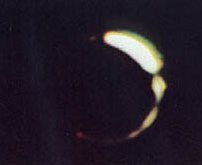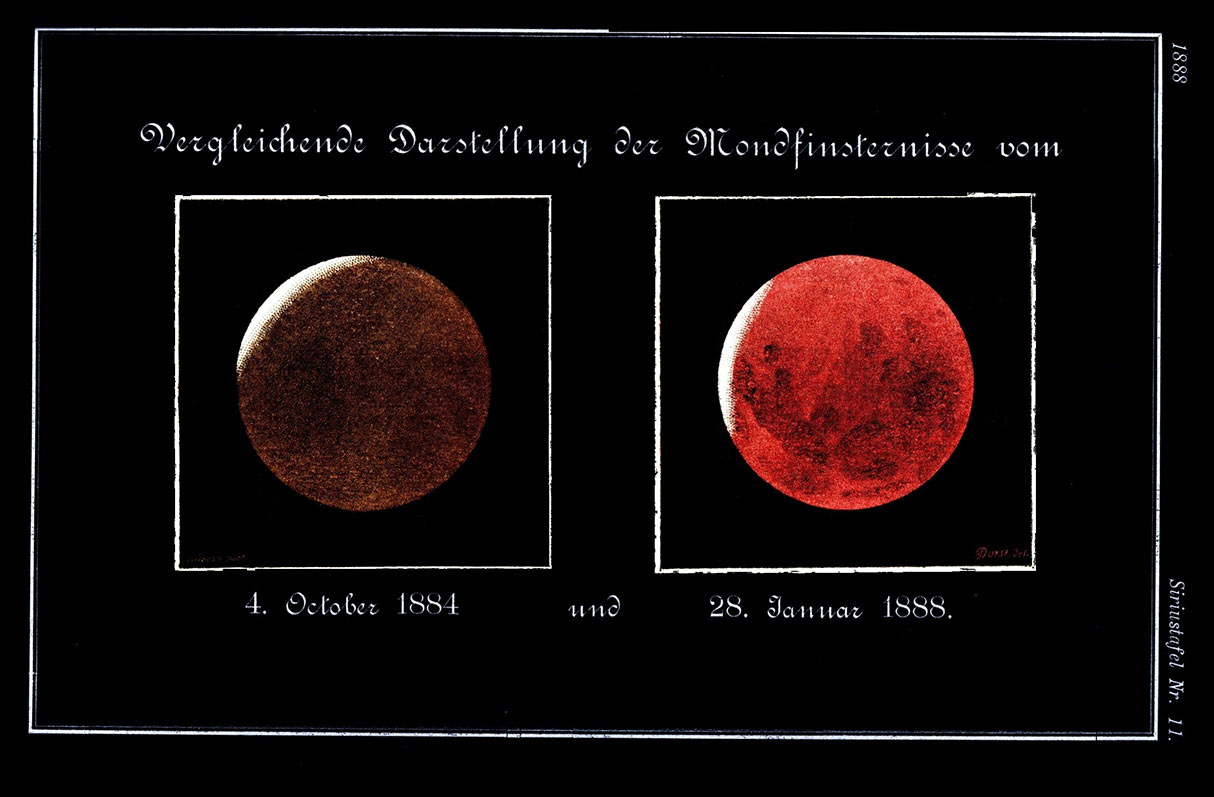Dull Grey or Copper-Orange:
What Will 2014's and 2015's Lunar Eclipses Look Like?
by Dr. Richard A. Keen
34296 Gap Road, Golden, CO 80403, USA
Over the next year and a half, Earthlings have four chances to watch a total eclipse of the Moon. This "tetrad" of lunar eclipses follows a break of over two years since the last total lunar eclipse in December 2011. That eclipse was poorly placed in the skies at my home in Colorado, and I had to travel to Hawaii for a better view. There, high in the sky, the eclipsed Moon shone a bright copper-orange, or, as one 19th century observer wrote, "like a glowing iron".
Not all lunar eclipses glow so warmly, however. An eclipse in 1992 appeared a dull brownish grey at best, and before that the moon all but disappeared from sight during the eclipse (as in 1963 and 1816). Although these dark eclipses are the unusual ones, it is really the bright orange luster of "normal" eclipses that require some explaining. During a total eclipse the Moon is completely immersed in the umbra, and, one should expect, totally cut off from sunlight. Then, why doesn't the Moon always disappear during an eclipse? The answer lies in the Earth's atmosphere: like a thin lens encircling our planet, the atmosphere bends (refracts) rays of sunlight as they pass by the edge of the Earth, focusing them into the umbra. The reddish hues come from the scattering of light by the molecules of air. Blue light is scattered most effectively (which is why the daytime sky is blue); removal of the blue light from a sunbeam leaves only the redder colors of the spectrum to continue on its path (which is why the setting Sun is red).
The thicker air of the lower atmosphere refracts light more strongly than does the upper atmosphere; however, it also absorbs more of the light. Clouds in the lowest ten or so miles (the troposphere) block even more sunlight. Thus, the deeper into the umbra (i.e., closer to the shadow's axis and to the Earth) one goes, the longer (and lower) is the path of the light rays through the atmosphere, and the darker it is. At the distance of the Moon, most of the light refracted into the umbra passes through the stratosphere, which lies 10 to 30 miles above the ground. Since the stratosphere is normally cloudless, the umbra (and therefore, the eclipsed Moon) is relatively bright.

During the total lunar eclipse of Apr. 24, 1967, NASA's Surveyor III lunar lander
witnessed an Earth-eclipse of the Sun from the surface of the Moon.
Only a crude snapshot chronicles the event.
The robot lunar lander Surveyor III observed a lunar eclipse in 1967 from a completely different perspective when it photographed the Sun's passage behind the Earth. At mid-eclipse the night side of the Earth was surrounded by a thin - but brilliant - ring of sunlight, broken here and there by the tops of the highest clouds. Total brightness of this ring was 10 to 100 times that of the full Moon as seen from Earth. When future astronauts and cosmonauts (none of the Apollo astronauts were so fortunate) witness this spectacle, they will, in a way, be gazing upon a most memorable sunset, with the setting Sun stretched all the way around the horizon that is the edge of the planet Earth.

The Total Lunar Eclipse of Dec. 9, 1992 was the darkest eclipse in over a decade.
Months before, millions of tons of gas and ash were spewed into the atmosphere
through volcanic eruptions of Mount Pinatubo (Phillipines)
(click for larger image)
If the atmospheric lens that illuminates the Moon becomes dirty enough, light will be blocked from entering the umbra. In 1991, the Philippine volcano Pinatubo spewed millions of tons of gas and ash into the atmosphere. Most of the volcanic "ash", minuscule grains of rock and lava, remained in the troposphere, and fell to Earth within days. However, a large volume of sulfur dioxide gas rose to the stratosphere, where it mixed with water vapor (some already in the stratosphere, and some thrown there by the eruption) to create a high-altitude cloud of micron-sized sulfuric acid droplets. This five-mile deep cloud was fairly transparent compared to most Earthly clouds. More like a haze layer, it dimmed the apparent brightness of stars by just one or two tenths of a magnitude. However, light rays grazing the Earth's edge on their way into the umbra passed nearly horizontally through the haze layer. The resulting path length of several hundred miles through the volcanic haze dimmed the sunlight by four magnitudes, and on Dec 9, 1992, the eclipsed Moon appeared no brighter than 2nd magnitude. Some of the light that didn't make it through the layer was scattered in all directions - and seen as brilliant red twilights.
Pinatubo was by no means the first volcano to tarnish the coppery glow of a lunar eclipse. Many who saw the Dec 1992 eclipse compared it to the dark eclipses of Dec 1982 and Dec 1963. The culprit volcanoes for those eclipses were El Chichon (Mexico) in 1982 and Gunung Agung (Bali) in 1963. An eclipse so dark as to be invisible followed the triple eruptions in 1902 of Pelee and Soufriere in the Caribbean and Santa Maria in Guatemala. A very dark eclipse in Oct 1884 followed the celebrated eruption of Krakatoa a year earlier.

A chromolithograph from the German astronomy magazine "Sirius" compares
the dark and featureless lunar disk during the eclipse a year after
the eruption of Krakatoa (left) with a bright eclipse four years later,
after the volcanic aerosols had settled out of the stratosphere (right).
(click for larger image)
Other dark eclipses following major volcanic eruptions were recorded during the 19th, 18th, and 17th centuries. In 1620, Johannes Kepler observed an eclipsed Moon so dark that "nothing could be seen of it, though the stars shone brightly all around", and although he was unaware of any volcanic eruptions, he correctly attributed the darkness to "mists and smoke" in the Earth's atmosphere. It may have been another unknown volcanic upheaval around A.D. 753 that ultimately led a reporter for the Anglo-Saxon Chronicle to describe the eclipsed Moon that year as "covered by a horrid black shield", in contrast to a more normal eclipse appearing "sprinkled with blood" 13 years earlier.

The Total Lunar Eclipse of Dec. 30, 1982 was the darkest eclipse since 1963.
The gloomy appearance was due to volcanic eruptions of El Chichon in Mexico.
(click for larger image)
Those high, globe-girdling clouds of volcanic sulfuric acid that keep sunlight from reaching the Moon during an eclipse also keep some sunlight from reaching the surface of the Earth. On a worldwide average, the Pinatubo cloud reduced the solar heating of the Earth's surface by a few percent. Theoretically, this could cool the global climate by a fraction of a degree for a duration of two or three years. Indeed, the summer of 1992 was the coldest since 1917 across the United States. The greatest eruption of modern times, that of Tambora (another Indonesian volcano) in 1815, is thought by many climatologists to have caused another "Year without a Summer" in 1816. The chilly weather yielded widespread crop failures in Europe and eastern North America, prompting many American farmers to migrate westward to interior of the continent. That same summer the Moon completely disappeared during a total eclipse, and there was speculation that the phenomena were related. However, the connection between volcanoes and climate (and the closely related issue, nuclear winter) remain controversial. Whether or not volcanoes cool the climate, observers of those occasional dark lunar eclipses can still marvel at how these geologic phenomena can literally cast their shadows on the Moon.
Amateur astronomers can measure the brightness of the eclipsed Moon by comparing it with stars or planets of known magnitude. The Moon, even during a total lunar eclipse, generally appears much bigger and brighter than the stars, and its size and brightness need to be reduced before direct comparisons can be made. An easy way to do this is to view the Moon through reversed binoculars with one eye, comparing the reduced lunar image with stars seen directly with the other eye. The estimated magnitude of the reduced Moon can be adjusted by a factor depending on the magnification of the binoculars, yielding the actual magnitude of the Moon. For example, reversed 10x50 binoculars will reduce the apparent diameter of the Moon by a factor of 10, or its brightness by a factor of 100, or 5 magnitudes. If the reduced Moon appears like a magnitude 3 star, the actual Moon is 5 magnitudes brighter, or -2. The corrections for 8x, 7x, and 6x binoculars are 4.5, 4.2, and 3.9 magnitudes, respectively.
Observations made from the beginning to end of totality will reveal the darkening of the Moon as it slips deeper into the umbra, while the brightness of the Moon at mid-eclipse may, when compared to the predicted magnitudes, reveal the presence of a volcanic haze layer. A comparison of the thicknesses of volcanic haze layers resulting from six major eruptions over the past 120 years is summarized in a Global Volcanism Program report (and in the slide presentations referenced below).
I welcome any and all reports on the brightness of future lunar eclipses for use in my volcano-climate studies. While actual brightness measurements (in magnitudes) made near mid-totality are most useful, I can also make use of Danjon Scale ratings of the eclipse. Please be sure to note the time, method, and instruments used in your reports.
Finally, back to the title question: What Will 2014's and 2015's Lunar Eclipses Look Like? Earth's volcanoes have been relatively quiet the past few years, and Pinatubo remains the last volcano to throw enough material into the stratosphere to affect either the climate or the appearance of the eclipsed moon. The stratosphere is still fairly clear, and barring a major eruption in the weeks before the eclipse, the April 2014 eclipse should be normally bright. The appearance of the October 2014 eclipse, and of the two eclipses in 2015, depends on how Earth's volcanoes behave over the next year. Since no one can predict global volcanic activity, the short answer to the questions is "Nobody knows" - and that gives us all the more reason to watch all of these upcoming eclipses.
Dr. Richard A. Keen
e-mail:
e-mail:
A copy of your observing report should also be emailed to .
References
- Keen, R. A., "Volcanic Aerosols and Lunar Eclipses", Science, vol. 222, p. 1011-1013, Dec. 2, 1983 (summary in Sky & Telescope, June 1984, page 512), (link to abstract).
The following links are for a more recent paper presented at the 2008 Solar Radiation and Climate Experiment workshop.
- Abstract: http://lasp.colorado.edu/sorce/news/2008ScienceMeeting/abstracts/4f_Keen.pdf
- PowerPoint: http://lasp.colorado.edu/sorce/news/2008ScienceMeeting/doc/Session4/S4_05_Keen.pdf
And an update presented in 2013 at the NOAA ESRL Global Monitoring Annual Conference May 21-22, 2013, Boulder, Colorado
"Earth (and Lunar) Based Observations of Volcanic Emissions to the Stratosphere – An Update Through 2011"

